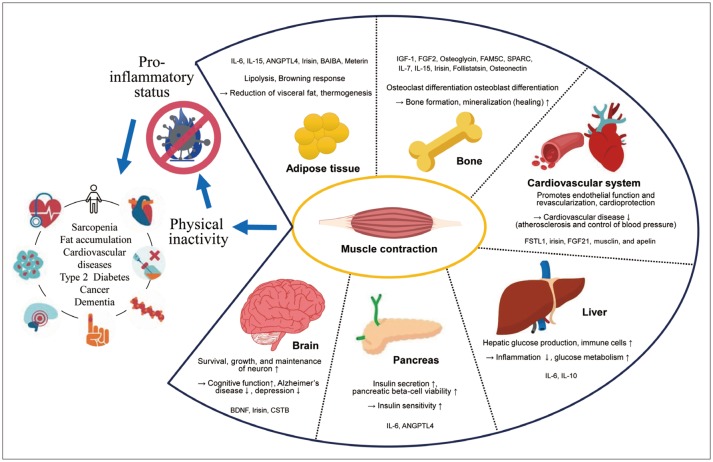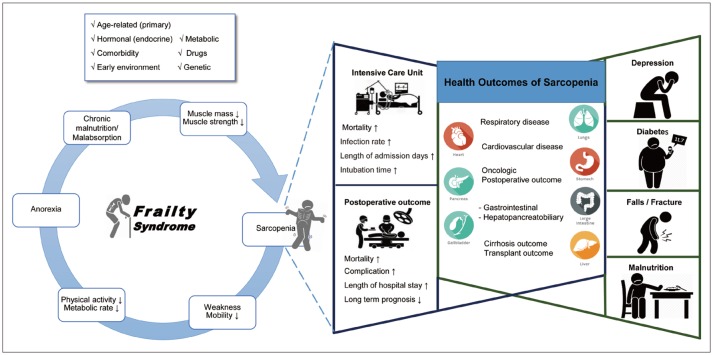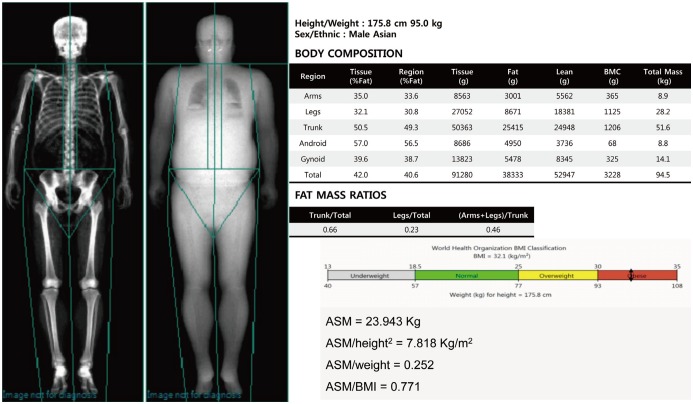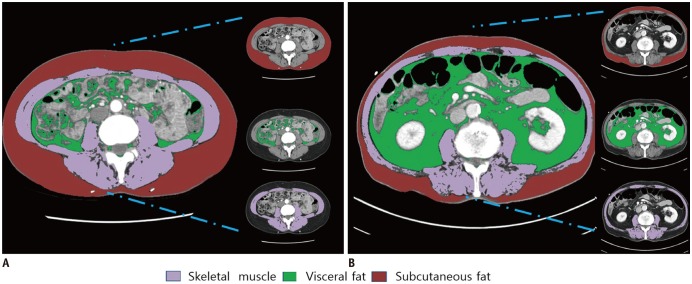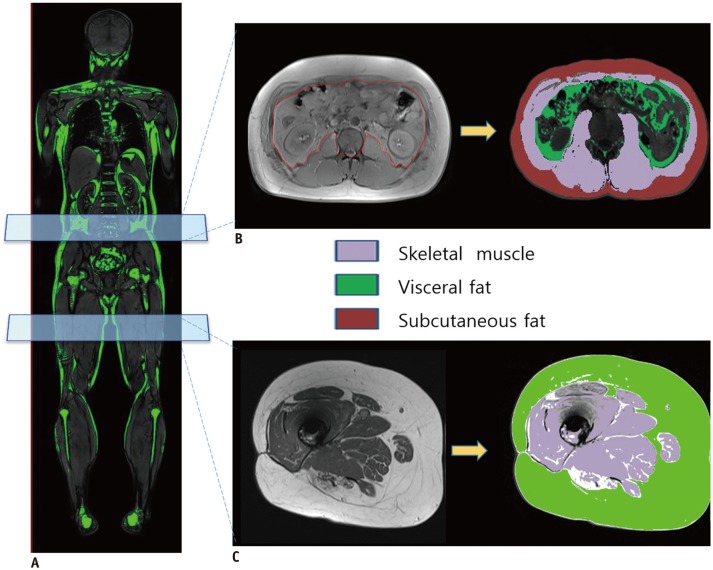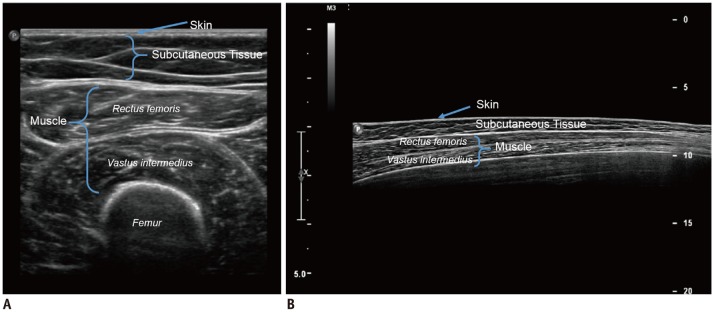Recent Issues on Body Composition Imaging for Sarcopenia Evaluation
- Affiliations
-
- 1Department of Radiology, Asan Image Metrics, Asan Medical Center, University of Ulsan College of Medicine, Seoul, Korea.
- 2Department of Radiology, Ajou University School of Medicine & Graduate School of Medicine, Ajou University Medical Center, Suwon, Korea. jimihuh.rad@gmail.com
- 3Department of Surgery, Asan Medical Center, University of Ulsan College of Medicine, Seoul, Korea.
- 4Department of Radiology, Wonkwang University College of Medicine, Wonkwang University Hospital, Iksan, Korea.
- KMID: 2438251
- DOI: http://doi.org/10.3348/kjr.2018.0479
Abstract
- Recently, sarcopenia has garnered renewed interest. Sarcopenia is a disease characterized by decreased skeletal muscle mass and strength/function, which can impair the quality of life and increase physical disability, adverse metabolic effects, and mortality. Imaging tools for evaluating and diagnosing sarcopenia have developed rapidly. Radiologists should be aware of sarcopenia and its clinical implications. We review current knowledge about sarcopenia, its pathophysiological impact, and advantages and disadvantages of methods for evaluation of sarcopenia focusing on body composition imaging modalities such as whole-body dual-energy X-ray absorptiometry, CT, and MRI. Controversial issues are discussed, including the lack of consensus and standardization of the disease definition, imaging modality, measurement methods, and diagnostic cutoff points.
Keyword
MeSH Terms
Figure
Cited by 6 articles
-
Sarcopenia as a Predictor of Prognosis in Early Stage Ovarian Cancer
Su Hyun Chae, Chulmin Lee, Sang-Hee Yoon, Seung-Hyuk Shim, Sun Joo Lee, Soo-Nyung Kim, Sochung Chung, Ji Young Lee
J Korean Med Sci. 2020;36(1):e2. doi: 10.3346/jkms.2021.36.e2.Prognostic Value of Skeletal Muscle Depletion Measured on Computed Tomography for Overall Survival in Patients with Non-Metastatic Breast Cancer
Jimi Huh, Bumhee Park, Heirim Lee, Young-Sil An, Yongsik Jung, Ji Young Kim, Doo Kyoung Kang, Kyung Won Kim, Tae Hee Kim
J Breast Cancer. 2020;23(1):80-92. doi: 10.4048/jbc.2020.23.e8.Influence of sarcopenia focused on critically ill patients
Belgin Akan
Acute Crit Care. 2021;36(1):15-21. doi: 10.4266/acc.2020.00745.Differences in Abdominal Body Composition According to Glycemic Status: An Inverse Probability Treatment Weighting Analysis
Seungbong Han, Young-Jee Jeon, Gyung-Min Park, Tae Young Lee, Soon Eun Park, Gyeongseok Yu, Byung Ju Kang
Endocrinol Metab. 2021;36(4):855-864. doi: 10.3803/EnM.2021.1086.Association of Myosteatosis with Nonalcoholic Fatty Liver Disease, Severity, and Liver Fibrosis Using Visual Muscular Quality Map in Computed Tomography
Hwi Seung Kim, Jiwoo Lee, Eun Hee Kim, Min Jung Lee, In Young Bae, Woo Je Lee, Joong-Yeol Park, Hong-Kyu Kim, Chang Hee Jung
Diabetes Metab J. 2023;47(1):104-117. doi: 10.4093/dmj.2022.0081.Upper thigh skeletal muscle index predicts outcomes in liver transplant recipients
Manuel Lim, Jong Man Kim, Jaehun Yang, Jieun Kwon, Kyeong Deok Kim, Eun Sung Jeong, Jinsoo Rhu, Gyu-Seong Choi, Jae-Won Joh, Suk-Koo Lee
Ann Surg Treat Res. 2023;105(4):219-227. doi: 10.4174/astr.2023.105.4.219.
Reference
-
1. Beaudart C, Zaaria M, Pasleau F, Reginster JY, Bruyère O. Health outcomes of sarcopenia: a systematic review and meta-analysis. PLoS One. 2017; 12:e0169548. PMID: 28095426.
Article2. Bazzocchi A, Diano D, Ponti F, Salizzoni E, Albisinni U, Marchesini G, et al. A 360-degree overview of body composition in healthy people: relationships among anthropometry, ultrasonography, and dual-energy x-ray absorptiometry. Nutrition. 2014; 30:696–701. PMID: 24800668.
Article3. Boutin RD, Yao L, Canter RJ, Lenchik L. Sarcopenia: current concepts and imaging implications. AJR Am J Roentgenol. 2015; 205:W255–W266. PMID: 26102307.
Article4. Santilli V, Bernetti A, Mangone M, Paoloni M. Clinical definition of sarcopenia. Clin Cases Miner Bone Metab. 2014; 11:177–180. PMID: 25568649.
Article5. Cruz-Jentoft AJ, Baeyens JP, Bauer JM, Boirie Y, Cederholm T, Landi F, et al. Sarcopenia: European consensus on definition and diagnosis: report of the European Working Group on sarcopenia in older people. Age Ageing. 2010; 39:412–423. PMID: 20392703.
Article6. Xue QL. The frailty syndrome: definition and natural history. Clin Geriatr Med. 2011; 27:1–15. PMID: 21093718.
Article7. Chen X, Mao G, Leng SX. Frailty syndrome: an overview. Clin Interv Aging. 2014; 9:433–441. PMID: 24672230.8. Cederholm T. Overlaps between Frailty and sarcopenia definitions. Nestle Nutr Inst Workshop Ser. 2015; 83:65–69. PMID: 26484770.
Article9. Anandavadivelan P, Lagergren P. Cachexia in patients with oesophageal cancer. Nat Rev Clin Oncol. 2016; 13:185–198. PMID: 26573424.
Article10. Cruz-Jentoft AJ, Landi F, Schneider SM, Zúñiga C, Arai H, Boirie Y, et al. Prevalence of and interventions for sarcopenia in ageing adults: a systematic review. Report of the International Sarcopenia Initiative (EWGSOP and IWGS). Age Ageing. 2014; 43:748–759. PMID: 25241753.
Article11. Wang C, Bai L. Sarcopenia in the elderly: basic and clinical issues. Geriatr Gerontol Int. 2012; 12:388–396. PMID: 22530761.
Article13. Laske C, Stransky E, Leyhe T, Eschweiler GW, Wittorf A, Richartz E, et al. Stage-dependent BDNF serum concentrations in Alzheimer's disease. J Neural Transm (Vienna). 2006; 113:1217–1224. PMID: 16362629.
Article14. Pratesi A, Tarantini F, Di Bari M. Skeletal muscle: an endocrine organ. Clin Cases Miner Bone Metab. 2013; 10:11–14. PMID: 23858303.
Article15. Kim KM, Jang HC, Lim S. Differences among skeletal muscle mass indices derived from height-, weight-, and body mass index-adjusted models in assessing sarcopenia. Korean J Intern Med. 2016; 31:643–650. PMID: 27334763.
Article16. Chin SO, Rhee SY, Chon S, Hwang YC, Jeong IK, Oh S, et al. Sarcopenia is independently associated with cardiovascular disease in older Korean adults: the Korea National Health and Nutrition Examination Survey (KNHANES) from 2009. PLoS One. 2013; 8:e60119. PMID: 23533671.
Article17. Sanada K, Miyachi M, Tanimoto M, Yamamoto K, Murakami H, Okumura S, et al. A cross-sectional study of sarcopenia in Japanese men and women: reference values and association with cardiovascular risk factors. Eur J Appl Physiol. 2010; 110:57–65. PMID: 20390291.
Article18. Levolger S, van Vugt JL, de Bruin RW, IJzermans JN. Systematic review of sarcopenia in patients operated on for gastrointestinal and hepatopancreatobiliary malignancies. Br J Surg. 2015; 102:1448–1458. PMID: 26375617.
Article19. Oakland K, Nadler R, Cresswell L, Jackson D, Coughlin PA. Systematic review and meta-analysis of the association between frailty and outcome in surgical patients. Ann R Coll Surg Engl. 2016; 98:80–85. PMID: 26741674.
Article20. Englesbe MJ, Patel SP, He K, Lynch RJ, Schaubel DE, Harbaugh C, et al. Sarcopenia and mortality after liver transplantation. J Am Coll Surg. 2010; 211:271–278. PMID: 20670867.
Article21. Ganapathi AM, Englum BR, Hanna JM, Schechter MA, Gaca JG, Hurwitz LM, et al. Frailty and risk in proximal aortic surgery. J Thorac Cardiovasc Surg. 2014; 147:186–191.e1. PMID: 24183336.
Article22. Lee JS, He K, Harbaugh CM, Schaubel DE, Sonnenday CJ, Wang SC, et al. Michigan Analytic Morphomics Group (MAMG). Frailty, core muscle size, and mortality in patients undergoing open abdominal aortic aneurysm repair. J Vasc Surg. 2011; 53:912–917. PMID: 21215580.
Article23. Peng P, Hyder O, Firoozmand A, Kneuertz P, Schulick RD, Huang D, et al. Impact of sarcopenia on outcomes following resection of pancreatic adenocarcinoma. J Gastrointest Surg. 2012; 16:1478–1486. PMID: 22692586.
Article24. de Hoogt PA, Reisinger KW, Tegels JJW, Bosmans JWAM, Tijssen F, Stoot JHMB. Functional Compromise Cohort Study (FCCS): sarcopenia is a strong predictor of mortality in the intensive care unit. World J Surg. 2018; 42:1733–1741. PMID: 29285609.
Article25. Du Y, Karvellas CJ, Baracos V, Williams DC, Khadaroo RG. Acute Care and Emergency Surgery (ACES) Group. Sarcopenia is a predictor of outcomes in very elderly patients undergoing emergency surgery. Surgery. 2014; 156:521–527. PMID: 24929435.
Article26. Miljkovic I, Zmuda JM. Epidemiology of myosteatosis. Curr Opin Clin Nutr Metab Care. 2010; 13:260–264. PMID: 20179586.
Article27. Reinders I, Murphy RA, Koster A, Brouwer IA, Visser M, Garcia ME, et al. Muscle quality and muscle fat infiltration in relation to incident mobility disability and gait speed decline: the age, gene/environment susceptibility-Reykjavik Study. J Gerontol A Biol Sci Med Sci. 2015; 70:1030–1036. PMID: 25748031.
Article28. Buford TW, Lott DJ, Marzetti E, Wohlgemuth SE, Vandenborne K, Pahor M, et al. Age-related differences in lower extremity tissue compartments and associations with physical function in older adults. Exp Gerontol. 2012; 47:38–44. PMID: 22015325.
Article29. Lorbergs AL, Noseworthy MD, Adachi JD, Stratford PW, MacIntyre NJ. Fat infiltration in the leg is associated with bone geometry and physical function in healthy older women. Calcif Tissue Int. 2015; 97:353–363. PMID: 26071112.
Article30. Hamrick MW, McGee-Lawrence ME, Frechette DM. Fatty infiltration of skeletal muscle: mechanisms and comparisons with bone marrow adiposity. Front Endocrinol (Lausanne). 2016; 7:69. PMID: 27379021.
Article31. Montano-Loza AJ, Angulo P, Meza-Junco J, Prado CM, Sawyer MB, Beaumont C, et al. Sarcopenic obesity and myosteatosis are associated with higher mortality in patients with cirrhosis. J Cachexia Sarcopenia Muscle. 2016; 7:126–135. PMID: 27493866.
Article32. Rollins KE, Tewari N, Ackner A, Awwad A, Madhusudan S, Macdonald IA, et al. The impact of sarcopenia and myosteatosis on outcomes of unresectable pancreatic cancer or distal cholangiocarcinoma. Clin Nutr. 2016; 35:1103–1109. PMID: 26411749.
Article33. Reinders I, Murphy RA, Brouwer IA, Visser M, Launer L, Siggeirsdottir K, et al. Muscle quality and myosteatosis: novel associations with mortality risk: the age, gene/environment susceptibility (AGES)-Reykjavik Study. Am J Epidemiol. 2016; 183:53–60. PMID: 26643983.34. Shepherd J. Evaluation of sarcopenia by DXA. Clin Rev Bone Miner Metab. 2016; 14:45–49.
Article35. Morrell GR, Ikizler TA, Chen X, Heilbrun ME, Wei G, Boucher R, et al. Psoas muscle cross-sectional area as a measure of whole-body lean muscle mass in maintenance hemodialysis patients. J Ren Nutr. 2016; 26:258–264. PMID: 26994780.36. Noumura Y, Kamishima T, Sutherland K, Nishimura H. Visceral adipose tissue area measurement at a single level: can it represent visceral adipose tissue volume? Br J Radiol. 2017; 90:20170253. PMID: 28707539.
Article37. Guerri S, Mercatelli D, Aparisi Gómez MP, Napoli A, Battista G, Guglielmi G, et al. Quantitative imaging techniques for the assessment of osteoporosis and sarcopenia. Quant Imaging Med Surg. 2018; 8:60–85. PMID: 29541624.
Article38. Baumgartner RN, Koehler KM, Gallagher D, Romero L, Heymsfield SB, Ross RR, et al. Epidemiology of sarcopenia among the elderly in New Mexico. Am J Epidemiol. 1998; 147:755–763. PMID: 9554417.
Article39. Fuggle N, Shaw S, Dennison E, Cooper C. Sarcopenia. Best Pract Res Clin Rheumatol. 2017; 31:218–242. PMID: 29224698.
Article40. Kim H, Hirano H, Edahiro A, Ohara Y, Watanabe Y, Kojima N, et al. Sarcopenia: prevalence and associated factors based on different suggested definitions in community-dwelling older adults. Geriatr Gerontol Int. 2016; 16(Suppl 1):110–122. PMID: 27018289.
Article41. Cawthon PM, Peters KW, Shardell MD, McLean RR, Dam TT, Kenny AM, et al. Cutpoints for low appendicular lean mass that identify older adults with clinically significant weakness. J Gerontol A Biol Sci Med Sci. 2014; 69:567–575. PMID: 24737559.
Article42. Seabolt LA, Welch EB, Silver HJ. Imaging methods for analyzing body composition in human obesity and cardiometabolic disease. Ann N Y Acad Sci. 2015; 1353:41–59. PMID: 26250623.
Article43. Sergi G, Trevisan C, Veronese N, Lucato P, Manzato E. Imaging of sarcopenia. Eur J Radiol. 2016; 85:1519–1524. PMID: 27117135.
Article44. Yoon DY, Moon JH, Kim HK, Choi CS, Chang SK, Yun EJ, et al. Comparison of low-dose CT and MR for measurement of intra-abdominal adipose tissue: a phantom and human study. Acad Radiol. 2008; 15:62–70. PMID: 18078908.45. Lustgarten MS, Fielding RA. Assessment of analytical methods used to measure changes in body composition in the elderly and recommendations for their use in phase II clinical trials. J Nutr Health Aging. 2011; 15:368–375. PMID: 21528163.
Article46. Dalakas MC. Inflammatory muscle diseases. N Engl J Med. 2015; 372:1734–1747. PMID: 25923553.
Article47. Erlandson MC, Lorbergs AL, Mathur S, Cheung AM. Muscle analysis using pQCT, DXA and MRI. Eur J Radiol. 2016; 85:1505–1511. PMID: 27005009.
Article48. Gloor M, Fasler S, Fischmann A, Haas T, Bieri O, Heinimann K, et al. Quantification of fat infiltration in oculopharyngeal muscular dystrophy: comparison of three MR imaging methods. J Magn Reson Imaging. 2011; 33:203–210. PMID: 21182140.
Article49. Prado CM, Lieffers JR, McCargar LJ, Reiman T, Sawyer MB, Martin L, et al. Prevalence and clinical implications of sarcopenic obesity in patients with solid tumours of the respiratory and gastrointestinal tracts: a population-based study. Lancet Oncol. 2008; 9:629–635. PMID: 18539529.
Article50. Martin L, Birdsell L, Macdonald N, Reiman T, Clandinin MT, McCargar LJ, et al. Cancer cachexia in the age of obesity: skeletal muscle depletion is a powerful prognostic factor, independent of body mass index. J Clin Oncol. 2013; 31:1539–1547. PMID: 23530101.
Article51. Schweitzer L, Geisler C, Pourhassan M, Braun W, Glüer CC, Bosy-Westphal A, et al. What is the best reference site for a single MRI slice to assess whole-body skeletal muscle and adipose tissue volumes in healthy adults? Am J Clin Nutr. 2015; 102:58–65. PMID: 26016860.52. Yip C, Dinkel C, Mahajan A, Siddique M, Cook GJ, Goh V. Imaging body composition in cancer patients: visceral obesity, sarcopenia and sarcopenic obesity may impact on clinical outcome. Insights Imaging. 2015; 6:489–497. PMID: 26070723.
Article53. Cheng X, Zhang Y, Wang C, Deng W, Wang L, Duanmu Y, et al. The optimal anatomic site for a single slice to estimate the total volume of visceral adipose tissue by using the quantitative computed tomography (QCT) in Chinese population. Eur J Clin Nutr. 2018; 3. 20. [Epub ahead of print]. DOI: 10.1038/s41430-018-0122-1.
Article54. Schweitzer L, Geisler C, Pourhassan M, Braun W, Glüer CC, Bosy-Westphal A, et al. Estimation of skeletal muscle mass and visceral adipose tissue volume by a single magnetic resonance imaging slice in healthy elderly adults. J Nutr. 2016; 146:2143–2148. PMID: 27581576.
Article55. Tosato M, Marzetti E, Cesari M, Savera G, Miller RR, Bernabei R, et al. Measurement of muscle mass in sarcopenia: from imaging to biochemical markers. Aging Clin Exp Res. 2017; 29:19–27. PMID: 28176249.
Article56. Xu L, Duanmu Y, Blake GM, Zhang C, Zhang Y, Brown K, et al. Validation of goose liver fat measurement by QCT and CSE-MRI with biochemical extraction and pathology as reference. Eur Radiol. 2018; 28:2003–2012. PMID: 29238866.
Article57. Ticinesi A, Meschi T, Narici MV, Lauretani F, Maggio M. Muscle ultrasound and sarcopenia in older individuals: a clinical perspective. J Am Med Dir Assoc. 2017; 18:290–300. PMID: 28202349.
Article58. Glüer CC. Quantitative ultrasound techniques for the assessment of osteoporosis: expert agreement on current status. The International Quantitative Ultrasound Consensus Group. J Bone Miner Res. 1997; 12:1280–1288. PMID: 9258759.
- Full Text Links
- Actions
-
Cited
- CITED
-
- Close
- Share
- Similar articles
-
- Diverse Abnormal Body Composition Phenotypes: Interaction Between Muscle, Fat, and Bone
- Clinical Implication of Sarcopenia in Patients with Inflammatory Bowel Disease
- Recent Progression in Sarcopenia and Sarcopenic Obesity
- Imaging Techniques for Nutritional Assessment
- Clinical and Physiopathological Mechanism of Sarcopenia

